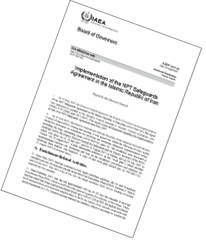
GOV/2007/28, like clockwork, is out on the ISIS website.
Items of note:
Hey, remember that David Sanger story about how, during the May 13 short notice inspection, “all the centrifuges appeared to be enriching uranium and running smoothly”? Yeah, well, the IAEA report states that “Between 17 March and 22 July 2007 … there was no feeding of nuclear material into the cascades.” I guess someone lied to you David, but, then again, you don’t give a f*ck, do you?
Iran is still underfeeding its centrifuges, although it is getting closer to the 70 grams/hour goal. The report states that “Since February 2007, Iran has fed approximately 690 kg of UF6 into the cascades at the Fuel Enrichment Plant (FEP), which is well below the expected quantity for a facility of this design.” We know the 12 cascades didn’t start operating until 22 July and that Iran used about 260 kg of hex during the 18 April-May 17 campaign. The 12 cascades consumed less than 430 kilograms during 22 July-19 August (29 days) or three-quarters the expected amount. Getting better but not really all that impressive.
- Iran claimed to have enriched uranium to 4.8 percent U-235, but IAEA environmental sampling says the best they have done is 3.7%. The IAEA will need to look at the products and tails before they know for sure.
- Iran has another 328 centrifuges close to operation (one operating without hex, another undergoing vacuum testing), with about 328 under construction. Guess they’ve finally pushed past the 2,000 mark. We’ll see how well those work.
Update: Ahem, I am eating a little crow today. The looks like the “no feed” reference is only to the PFEP. Don’t have the dates on the FEP cascade operation, yet. That let’s Sanger off the hook — maybe — and drops the operating rate down substantially.

Some of my concerns with the “modality plan” were affirmed in Albright’s short critique. The failure to mention the Additional Protocol is a big one. The IAEA should have been adamant about having Iran fulfill its international obligations.
Look, I want the Iranians back into compliance with the Additional Protocol as well. I think the report makes clear that the IAEA shares that position:
I think that is about as adamant as the IAEA can be, legally speaking. The IAEA states that it cannot be confident in the peaceful nature of Iran’s program without implementation of the Additional Protocol. Perhaps the only “tougher” thing the IAEA might have done is reiterate the position Oli Heinonen took in his 18 April letter that Iran cannot revert to the pre-Additional Protocol 1976 subsidiary arrangements without the consent of both parties.
Just a note, while Paul’s reporting did show that Sanger’s comment was off base, the IAEA quote about not feeding nuclear material into the cascades in that time period was talking about the PFEP, not the FEP (Sanger and Paul were both talking about the FEP).
The part of the report that I found very reassuring after the release of that work plan was this:
“Once Iran’s past nuclear programme has been clarified, Iran would need to continue to build confidence about the scope and nature of its present and future nuclear programme. Confidence in the exclusively peaceful nature of Iran’s nuclear programme requires that the Agency be able to provide assurances not only regarding declared nuclear material, but, equally important, regarding the absence of undeclared nuclear material and activities in Iran, through the implementation of the Additional Protocol. The Director General therefore again urges Iran to ratify and bring into force the Additional Protocol at the earliest possible date, as requested by the Board of Governors and the Security Council.”
So it looks like the Agency’s interpretation of this:
“The Agency and Iran agreed that after the implementation of the above work plan and the agreed modalities for resolving the outstanding issues, the implementation of safeguards in Iran will be conducted in a routine manner.”
…is Iran still needs to get it’s AP in force.
Not so fast Iran….
Wanted to clarify my last post. By “that time period” I just meant the 17 March to 22 July timeframe. Should have been clearer…
As the unresolved questions are either answered or in progress, I expect the imposition of sanctions on Iran for failing to ratify an additional protocol, which is voluntary, to be a very difficult sell.
I also expect Iran to sign and ratify an additional protocol when it’s clear either that the terms will not or they cannot be used to pressure Iran to give up enrichment, for example after Iran has sufficiently mastered the technology or after Iran’s right to enrich is explicitly confirmed in negotiations.
An additional protocol does not remove or even really limit a nation’s theoretical nuclear capability.
The important thing is it seems like the unresolved questions are on hold and heading towards going away.
By statements I’ve read from their foreign ministries, those questions had been the heart and soul of the Russian and Chinese cooperation with the sanctions drive.
why should we believe the IAEA environmental sample results? There’s no way to be absolutely sure that they haven’t processed more UF than they have reported nor acheived a higher enrichment than sampling suggests. I find it very hard to believe that they are intentionally operating the cascades at 10% of potential (NY Times article).
Does anyone have access to the details that the IAEA reports are based on?
The IAEA states that it cannot be confident in the peaceful nature of Iran’s program without implementation of the Additional Protocol…and the same goes for other 36 states. Iran implemented the AP for about 2 years previously and has offered to ratify it once its rights are recognized.